Business Finance: Financial Management, Statements & Analysis
VerifiedAdded on 2023/06/18
|11
|2626
|69
Report
AI Summary
This report delves into the core concepts and importance of financial management, highlighting its role in financial decision-making, defining investment opportunities, forming capital structures, financial planning, and managing economic growth and stability. It examines major financial statements including the Balance Sheet, Income Statement, Cash Flow Statement, and Statement of Equity, emphasizing the use of ratios in financial management for assessing profitability, liquidity, and efficiency. The report includes a completed business review template with interpretations on profitability, liquidity, and efficiency positions, and concludes with an overview of processes businesses can use to improve their financial performance, such as restructuring, investment replanning, professional advisory services, and enhanced marketing techniques. This document provides a comprehensive overview of key financial principles and practices.

BUSINESS FINANCE
Paraphrase This Document
Need a fresh take? Get an instant paraphrase of this document with our AI Paraphraser
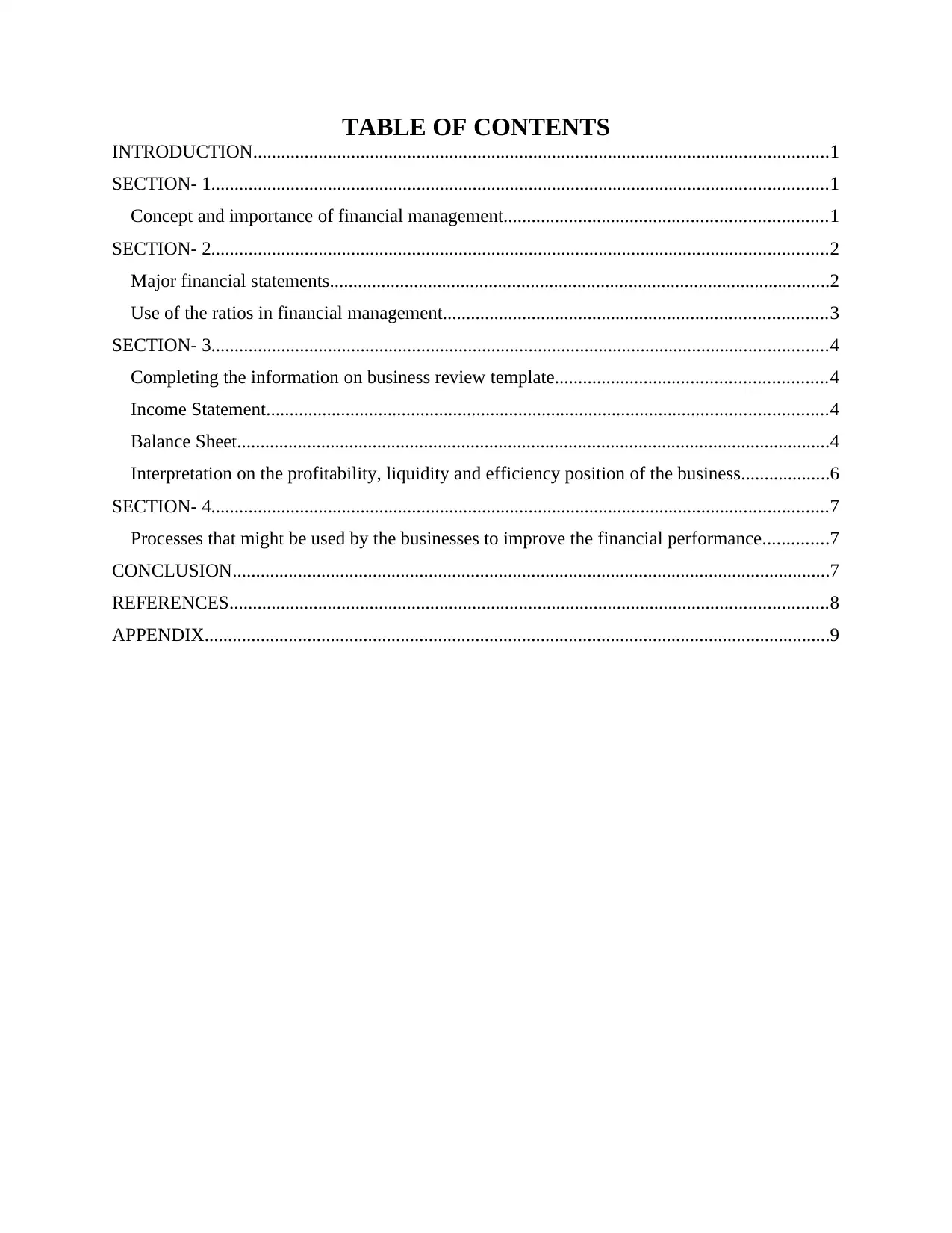
TABLE OF CONTENTS
INTRODUCTION...........................................................................................................................1
SECTION- 1....................................................................................................................................1
Concept and importance of financial management.....................................................................1
SECTION- 2....................................................................................................................................2
Major financial statements...........................................................................................................2
Use of the ratios in financial management..................................................................................3
SECTION- 3....................................................................................................................................4
Completing the information on business review template..........................................................4
Income Statement........................................................................................................................4
Balance Sheet...............................................................................................................................4
Interpretation on the profitability, liquidity and efficiency position of the business...................6
SECTION- 4....................................................................................................................................7
Processes that might be used by the businesses to improve the financial performance..............7
CONCLUSION................................................................................................................................7
REFERENCES................................................................................................................................8
APPENDIX......................................................................................................................................9
INTRODUCTION...........................................................................................................................1
SECTION- 1....................................................................................................................................1
Concept and importance of financial management.....................................................................1
SECTION- 2....................................................................................................................................2
Major financial statements...........................................................................................................2
Use of the ratios in financial management..................................................................................3
SECTION- 3....................................................................................................................................4
Completing the information on business review template..........................................................4
Income Statement........................................................................................................................4
Balance Sheet...............................................................................................................................4
Interpretation on the profitability, liquidity and efficiency position of the business...................6
SECTION- 4....................................................................................................................................7
Processes that might be used by the businesses to improve the financial performance..............7
CONCLUSION................................................................................................................................7
REFERENCES................................................................................................................................8
APPENDIX......................................................................................................................................9
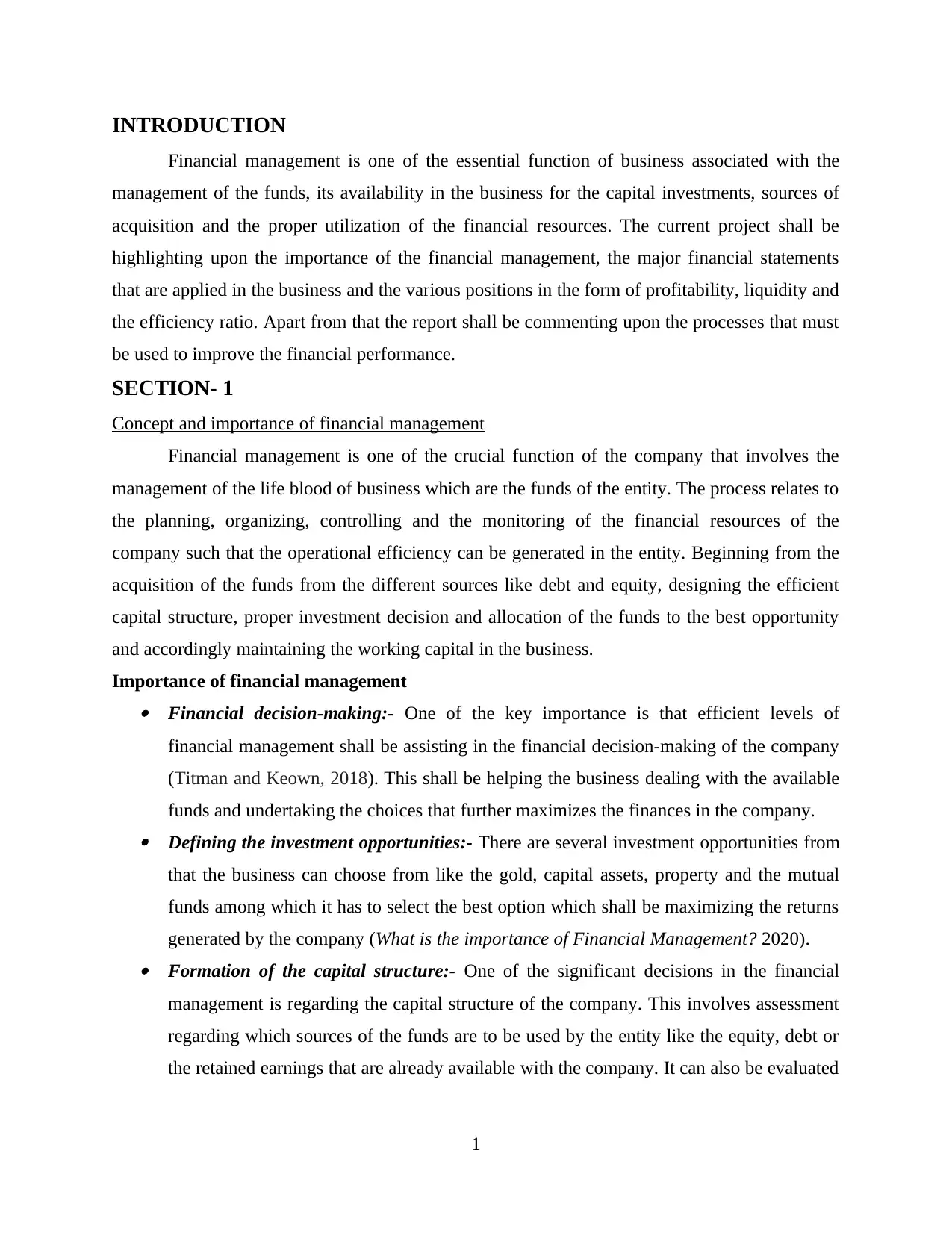
INTRODUCTION
Financial management is one of the essential function of business associated with the
management of the funds, its availability in the business for the capital investments, sources of
acquisition and the proper utilization of the financial resources. The current project shall be
highlighting upon the importance of the financial management, the major financial statements
that are applied in the business and the various positions in the form of profitability, liquidity and
the efficiency ratio. Apart from that the report shall be commenting upon the processes that must
be used to improve the financial performance.
SECTION- 1
Concept and importance of financial management
Financial management is one of the crucial function of the company that involves the
management of the life blood of business which are the funds of the entity. The process relates to
the planning, organizing, controlling and the monitoring of the financial resources of the
company such that the operational efficiency can be generated in the entity. Beginning from the
acquisition of the funds from the different sources like debt and equity, designing the efficient
capital structure, proper investment decision and allocation of the funds to the best opportunity
and accordingly maintaining the working capital in the business.
Importance of financial management Financial decision-making:- One of the key importance is that efficient levels of
financial management shall be assisting in the financial decision-making of the company
(Titman and Keown, 2018). This shall be helping the business dealing with the available
funds and undertaking the choices that further maximizes the finances in the company. Defining the investment opportunities:- There are several investment opportunities from
that the business can choose from like the gold, capital assets, property and the mutual
funds among which it has to select the best option which shall be maximizing the returns
generated by the company (What is the importance of Financial Management? 2020). Formation of the capital structure:- One of the significant decisions in the financial
management is regarding the capital structure of the company. This involves assessment
regarding which sources of the funds are to be used by the entity like the equity, debt or
the retained earnings that are already available with the company. It can also be evaluated
1
Financial management is one of the essential function of business associated with the
management of the funds, its availability in the business for the capital investments, sources of
acquisition and the proper utilization of the financial resources. The current project shall be
highlighting upon the importance of the financial management, the major financial statements
that are applied in the business and the various positions in the form of profitability, liquidity and
the efficiency ratio. Apart from that the report shall be commenting upon the processes that must
be used to improve the financial performance.
SECTION- 1
Concept and importance of financial management
Financial management is one of the crucial function of the company that involves the
management of the life blood of business which are the funds of the entity. The process relates to
the planning, organizing, controlling and the monitoring of the financial resources of the
company such that the operational efficiency can be generated in the entity. Beginning from the
acquisition of the funds from the different sources like debt and equity, designing the efficient
capital structure, proper investment decision and allocation of the funds to the best opportunity
and accordingly maintaining the working capital in the business.
Importance of financial management Financial decision-making:- One of the key importance is that efficient levels of
financial management shall be assisting in the financial decision-making of the company
(Titman and Keown, 2018). This shall be helping the business dealing with the available
funds and undertaking the choices that further maximizes the finances in the company. Defining the investment opportunities:- There are several investment opportunities from
that the business can choose from like the gold, capital assets, property and the mutual
funds among which it has to select the best option which shall be maximizing the returns
generated by the company (What is the importance of Financial Management? 2020). Formation of the capital structure:- One of the significant decisions in the financial
management is regarding the capital structure of the company. This involves assessment
regarding which sources of the funds are to be used by the entity like the equity, debt or
the retained earnings that are already available with the company. It can also be evaluated
1
⊘ This is a preview!⊘
Do you want full access?
Subscribe today to unlock all pages.

Trusted by 1+ million students worldwide
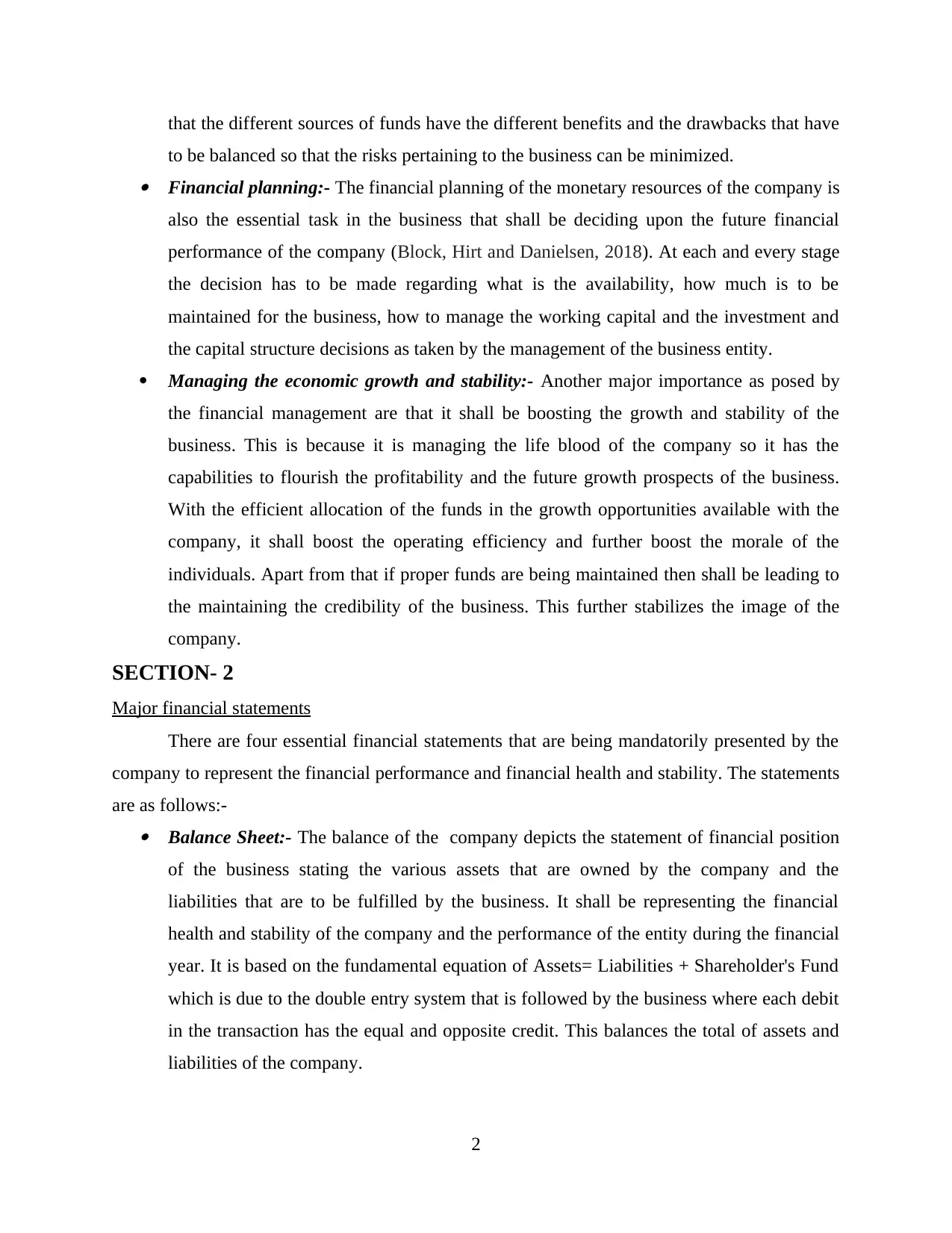
that the different sources of funds have the different benefits and the drawbacks that have
to be balanced so that the risks pertaining to the business can be minimized. Financial planning:- The financial planning of the monetary resources of the company is
also the essential task in the business that shall be deciding upon the future financial
performance of the company (Block, Hirt and Danielsen, 2018). At each and every stage
the decision has to be made regarding what is the availability, how much is to be
maintained for the business, how to manage the working capital and the investment and
the capital structure decisions as taken by the management of the business entity.
Managing the economic growth and stability:- Another major importance as posed by
the financial management are that it shall be boosting the growth and stability of the
business. This is because it is managing the life blood of the company so it has the
capabilities to flourish the profitability and the future growth prospects of the business.
With the efficient allocation of the funds in the growth opportunities available with the
company, it shall boost the operating efficiency and further boost the morale of the
individuals. Apart from that if proper funds are being maintained then shall be leading to
the maintaining the credibility of the business. This further stabilizes the image of the
company.
SECTION- 2
Major financial statements
There are four essential financial statements that are being mandatorily presented by the
company to represent the financial performance and financial health and stability. The statements
are as follows:- Balance Sheet:- The balance of the company depicts the statement of financial position
of the business stating the various assets that are owned by the company and the
liabilities that are to be fulfilled by the business. It shall be representing the financial
health and stability of the company and the performance of the entity during the financial
year. It is based on the fundamental equation of Assets= Liabilities + Shareholder's Fund
which is due to the double entry system that is followed by the business where each debit
in the transaction has the equal and opposite credit. This balances the total of assets and
liabilities of the company.
2
to be balanced so that the risks pertaining to the business can be minimized. Financial planning:- The financial planning of the monetary resources of the company is
also the essential task in the business that shall be deciding upon the future financial
performance of the company (Block, Hirt and Danielsen, 2018). At each and every stage
the decision has to be made regarding what is the availability, how much is to be
maintained for the business, how to manage the working capital and the investment and
the capital structure decisions as taken by the management of the business entity.
Managing the economic growth and stability:- Another major importance as posed by
the financial management are that it shall be boosting the growth and stability of the
business. This is because it is managing the life blood of the company so it has the
capabilities to flourish the profitability and the future growth prospects of the business.
With the efficient allocation of the funds in the growth opportunities available with the
company, it shall boost the operating efficiency and further boost the morale of the
individuals. Apart from that if proper funds are being maintained then shall be leading to
the maintaining the credibility of the business. This further stabilizes the image of the
company.
SECTION- 2
Major financial statements
There are four essential financial statements that are being mandatorily presented by the
company to represent the financial performance and financial health and stability. The statements
are as follows:- Balance Sheet:- The balance of the company depicts the statement of financial position
of the business stating the various assets that are owned by the company and the
liabilities that are to be fulfilled by the business. It shall be representing the financial
health and stability of the company and the performance of the entity during the financial
year. It is based on the fundamental equation of Assets= Liabilities + Shareholder's Fund
which is due to the double entry system that is followed by the business where each debit
in the transaction has the equal and opposite credit. This balances the total of assets and
liabilities of the company.
2
Paraphrase This Document
Need a fresh take? Get an instant paraphrase of this document with our AI Paraphraser

Income Statement:- The profit and loss statement of the company shall be accounting for
all the incomes and the expenses that are incurred in the business and through that shall
be depicting the profitability position of the organization (The four basic financial
statements, 2021). The profits are in the form of gross profit, operating profit and the net
profit revealing the operational efficiency which the routine operations of the business are
being conducted. The higher are the profits the better is the company position. Cash Flow Statement:- This statement as formed by the company shall be showing the
inflows and the outflows of cash and cash equivalents in the business. It shall be
accounting for all the cash transactions that have been incurred during the period of
assessment and based on that shall be determining the closing balance of cash (Brigham
and Houston, 2021). It shall be evaluating the liquidity position of the company and
based on that shall be assessing whether it is sufficient for meeting the current liabilities
and obligations of the company. It is divided into three types of activities one is the
operating, investing and the financing activity under which the cash transactions of the
company are recorded.
Statement of Equity:- It shall be recording the changes in the balance of equity during
the financial year which can be due to additional shares issued, buyback, bonus shares,
dividend payment etc. These shall be altering the balance of the shareholder's fund in the
company.
Use of the ratios in financial management
The ratio analysis of the company depicting the profitability, liquidity and efficiency
position shall be useful in the financial management and taking the various decisions that are
associated with the funds in the company. The different decisions like the investment, capital
structure, financing and the working capital are based on the performance that is being
enunciated by the ratio analysis of the financial statement (Yap, Komalasari and Hadiansah,
2018). If it can be interpreted that the liquidity position is weak then in that case the investment
opportunities shall be accordingly decided like the short term ones or which provides the
frequent returns. Suppose it is known that the efficiency of the operations is poor then the
investments are to be made in capital assets like the plant and machinery having faster
technology providing better results. So it can be assessed that the ratios are helpful in knowing
3
all the incomes and the expenses that are incurred in the business and through that shall
be depicting the profitability position of the organization (The four basic financial
statements, 2021). The profits are in the form of gross profit, operating profit and the net
profit revealing the operational efficiency which the routine operations of the business are
being conducted. The higher are the profits the better is the company position. Cash Flow Statement:- This statement as formed by the company shall be showing the
inflows and the outflows of cash and cash equivalents in the business. It shall be
accounting for all the cash transactions that have been incurred during the period of
assessment and based on that shall be determining the closing balance of cash (Brigham
and Houston, 2021). It shall be evaluating the liquidity position of the company and
based on that shall be assessing whether it is sufficient for meeting the current liabilities
and obligations of the company. It is divided into three types of activities one is the
operating, investing and the financing activity under which the cash transactions of the
company are recorded.
Statement of Equity:- It shall be recording the changes in the balance of equity during
the financial year which can be due to additional shares issued, buyback, bonus shares,
dividend payment etc. These shall be altering the balance of the shareholder's fund in the
company.
Use of the ratios in financial management
The ratio analysis of the company depicting the profitability, liquidity and efficiency
position shall be useful in the financial management and taking the various decisions that are
associated with the funds in the company. The different decisions like the investment, capital
structure, financing and the working capital are based on the performance that is being
enunciated by the ratio analysis of the financial statement (Yap, Komalasari and Hadiansah,
2018). If it can be interpreted that the liquidity position is weak then in that case the investment
opportunities shall be accordingly decided like the short term ones or which provides the
frequent returns. Suppose it is known that the efficiency of the operations is poor then the
investments are to be made in capital assets like the plant and machinery having faster
technology providing better results. So it can be assessed that the ratios are helpful in knowing
3

the status of the company and based on that making the financial choices, allocation of the funds
and the sources of finance in the company
SECTION- 3
Completing the information on business review template
2016
£’000
2015
£’000
Change
%
Turnover (continuing operations) 189,711 179,587 +5.6%
Profit for the financial year 43057 18,987 + 127%
Shareholder’s equity 83802.75 63,057 +32.9%
Current assets as % of current liabilities 54.72 % 304% -82%
Customer satisfaction 4.5 4.1 +10%
Average number of employees 649 618 +5%
Gross Profit for the year 2016 = Sales - COGS
= 189,711 -108,586 = £81125
Net Profit for 2016 = Sales- COGS- administration – operating expenses- interest
= 189,711 -108,586 - 13,751 - 22,374 – 1943 = £43057
Net Profit increased in 2016 by 127 % [(43057 – 18987) / 18987 *100] during the year.
Shareholders’ equity increased by 32.9% by £83802.75 (63057 * (1+32.9%).
The company’s “quick ratio” (Current Assets (excluding stock) divided by Current Liabilities) is
£55778 / 37928 = 1.47.
The company’s “current ratio” (Current Assets divided by Current Liabilities.) is £84349 /
£37928 = 2.22.
Income Statement
Attached in Appendix.
Balance Sheet
2016
Total
4
and the sources of finance in the company
SECTION- 3
Completing the information on business review template
2016
£’000
2015
£’000
Change
%
Turnover (continuing operations) 189,711 179,587 +5.6%
Profit for the financial year 43057 18,987 + 127%
Shareholder’s equity 83802.75 63,057 +32.9%
Current assets as % of current liabilities 54.72 % 304% -82%
Customer satisfaction 4.5 4.1 +10%
Average number of employees 649 618 +5%
Gross Profit for the year 2016 = Sales - COGS
= 189,711 -108,586 = £81125
Net Profit for 2016 = Sales- COGS- administration – operating expenses- interest
= 189,711 -108,586 - 13,751 - 22,374 – 1943 = £43057
Net Profit increased in 2016 by 127 % [(43057 – 18987) / 18987 *100] during the year.
Shareholders’ equity increased by 32.9% by £83802.75 (63057 * (1+32.9%).
The company’s “quick ratio” (Current Assets (excluding stock) divided by Current Liabilities) is
£55778 / 37928 = 1.47.
The company’s “current ratio” (Current Assets divided by Current Liabilities.) is £84349 /
£37928 = 2.22.
Income Statement
Attached in Appendix.
Balance Sheet
2016
Total
4
⊘ This is a preview!⊘
Do you want full access?
Subscribe today to unlock all pages.

Trusted by 1+ million students worldwide
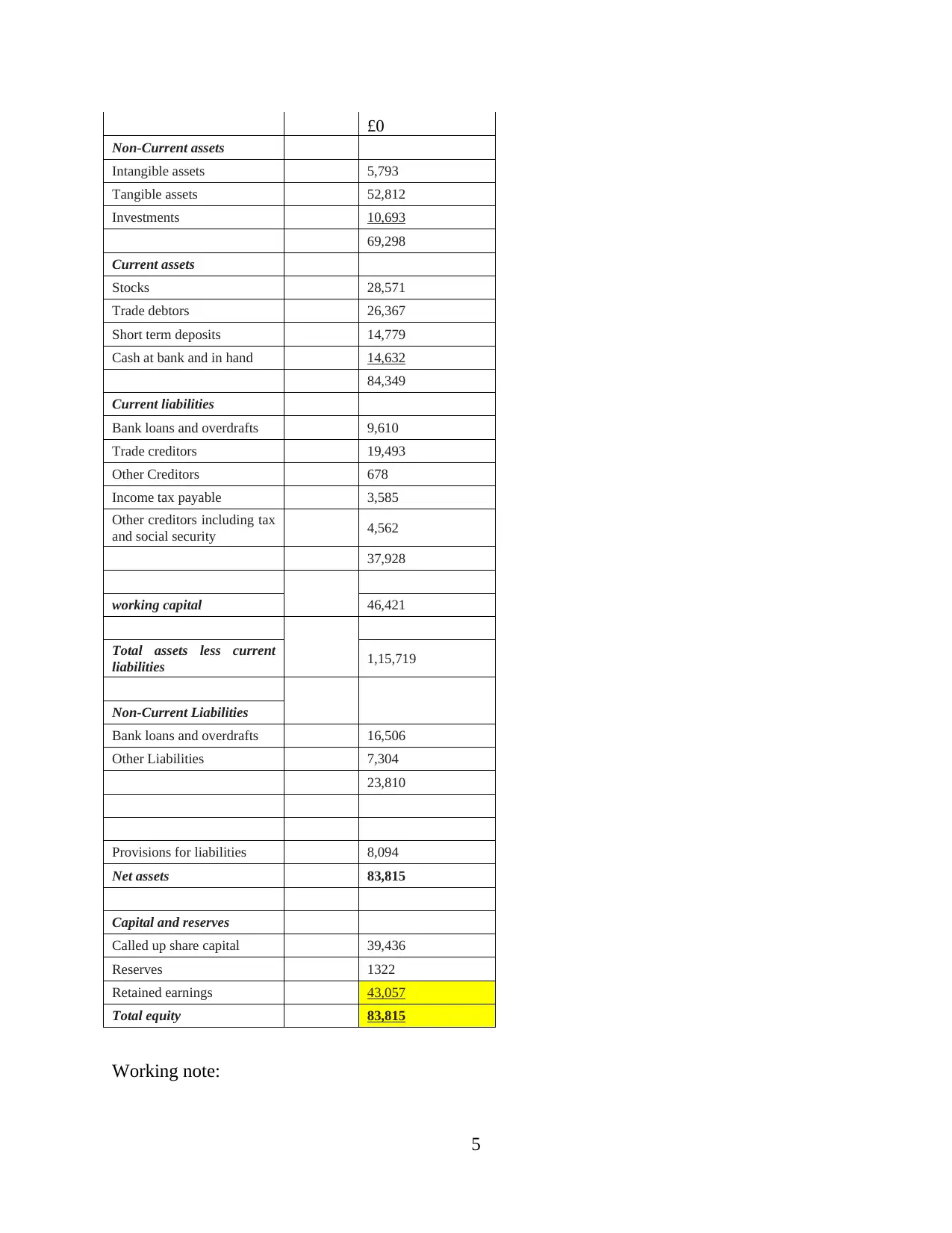
£0
Non-Current assets
Intangible assets 5,793
Tangible assets 52,812
Investments 10,693
69,298
Current assets
Stocks 28,571
Trade debtors 26,367
Short term deposits 14,779
Cash at bank and in hand 14,632
84,349
Current liabilities
Bank loans and overdrafts 9,610
Trade creditors 19,493
Other Creditors 678
Income tax payable 3,585
Other creditors including tax
and social security 4,562
37,928
working capital 46,421
Total assets less current
liabilities 1,15,719
Non-Current Liabilities
Bank loans and overdrafts 16,506
Other Liabilities 7,304
23,810
Provisions for liabilities 8,094
Net assets 83,815
Capital and reserves
Called up share capital 39,436
Reserves 1322
Retained earnings 43,057
Total equity 83,815
Working note:
5
Non-Current assets
Intangible assets 5,793
Tangible assets 52,812
Investments 10,693
69,298
Current assets
Stocks 28,571
Trade debtors 26,367
Short term deposits 14,779
Cash at bank and in hand 14,632
84,349
Current liabilities
Bank loans and overdrafts 9,610
Trade creditors 19,493
Other Creditors 678
Income tax payable 3,585
Other creditors including tax
and social security 4,562
37,928
working capital 46,421
Total assets less current
liabilities 1,15,719
Non-Current Liabilities
Bank loans and overdrafts 16,506
Other Liabilities 7,304
23,810
Provisions for liabilities 8,094
Net assets 83,815
Capital and reserves
Called up share capital 39,436
Reserves 1322
Retained earnings 43,057
Total equity 83,815
Working note:
5
Paraphrase This Document
Need a fresh take? Get an instant paraphrase of this document with our AI Paraphraser

Total Assets 153,647
Less: Total Liabilities 69,832
Total equity 83,815
Interpretation on the profitability, liquidity and efficiency position of the business
In terms of liquidity, the current ratio and quick ratio derived above depicts that the
company is having sufficient amount of current assets in order to meet with its current
obligations (Wadhwa, 2019). This indicates that the company is having a strong liquidity
position which will help in effectively carrying out the business operations.
On account of profitability, the GP ratio has decrease in the year 2016 while there is a
rise in NP ratio because of increase in sales. The decline in GP ratio might be due to rise in
COGS which is having a direct impact on gross profits of the company.
Particulars Formula 2015 2016
Gross profit 80612 81125
Net Profit 18,987 43057
Sales 179,587 189,711
Gross profit Ratio Gross profit/
sales*100
44.88 42.76
Net Profit ratio Net Profit/
sales*100
10.57 22.69
Particulars Formula 2016
Stock 28,571
COGS 108586
Inventory turnover
ratio
COGS /
Average stock
3.8
In respect to efficiency ratio, the inventory turnover ratio of the company as given below is low
which clearly states the risky situation for the firm (Awo and Akotey, 2019). This means that the
company is not effective enough in regard to selling out its inventory quickly. This might lead to
wastage of stock or incurring unnecessary cost pertaining to managing its inventory.
6
Less: Total Liabilities 69,832
Total equity 83,815
Interpretation on the profitability, liquidity and efficiency position of the business
In terms of liquidity, the current ratio and quick ratio derived above depicts that the
company is having sufficient amount of current assets in order to meet with its current
obligations (Wadhwa, 2019). This indicates that the company is having a strong liquidity
position which will help in effectively carrying out the business operations.
On account of profitability, the GP ratio has decrease in the year 2016 while there is a
rise in NP ratio because of increase in sales. The decline in GP ratio might be due to rise in
COGS which is having a direct impact on gross profits of the company.
Particulars Formula 2015 2016
Gross profit 80612 81125
Net Profit 18,987 43057
Sales 179,587 189,711
Gross profit Ratio Gross profit/
sales*100
44.88 42.76
Net Profit ratio Net Profit/
sales*100
10.57 22.69
Particulars Formula 2016
Stock 28,571
COGS 108586
Inventory turnover
ratio
COGS /
Average stock
3.8
In respect to efficiency ratio, the inventory turnover ratio of the company as given below is low
which clearly states the risky situation for the firm (Awo and Akotey, 2019). This means that the
company is not effective enough in regard to selling out its inventory quickly. This might lead to
wastage of stock or incurring unnecessary cost pertaining to managing its inventory.
6
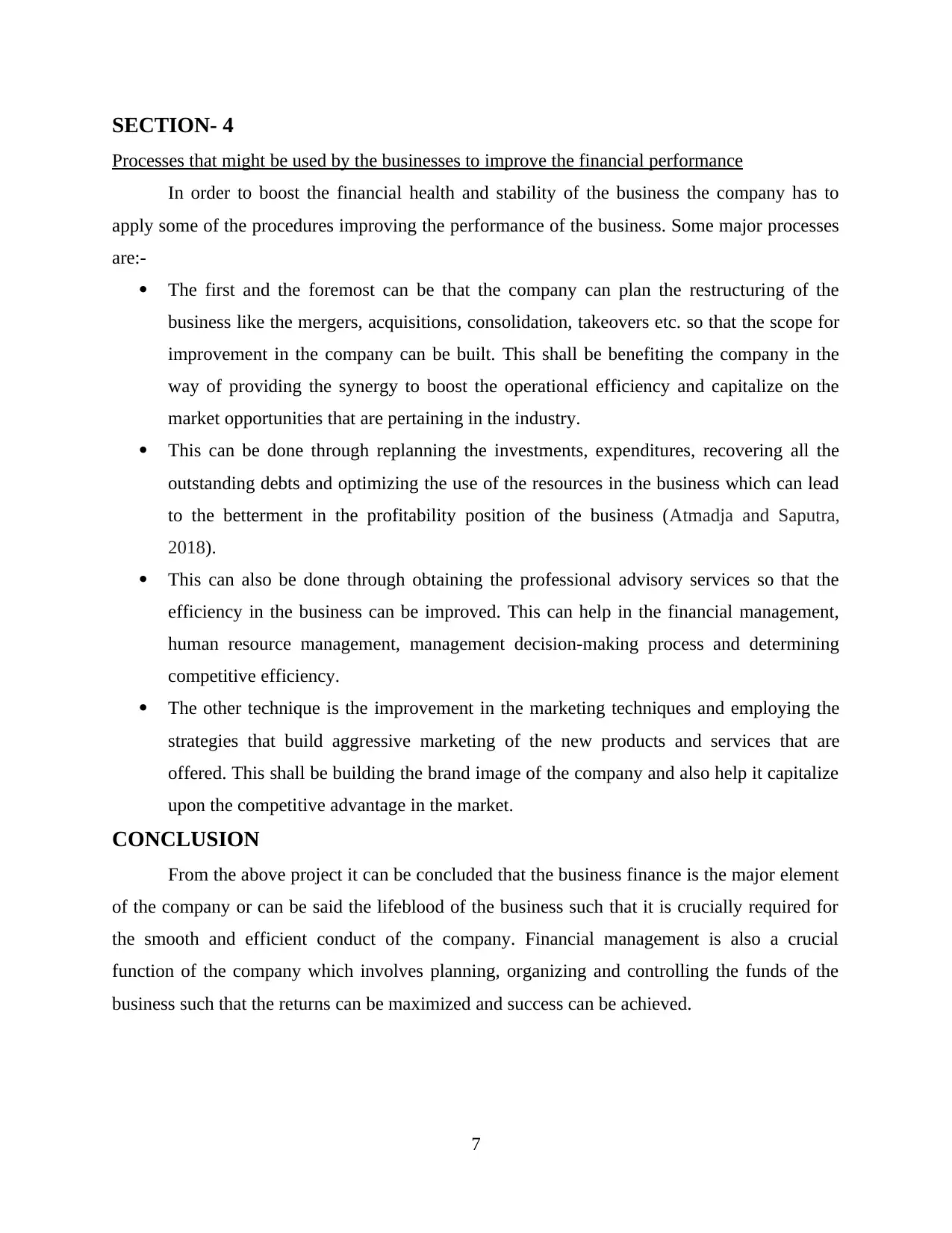
SECTION- 4
Processes that might be used by the businesses to improve the financial performance
In order to boost the financial health and stability of the business the company has to
apply some of the procedures improving the performance of the business. Some major processes
are:-
The first and the foremost can be that the company can plan the restructuring of the
business like the mergers, acquisitions, consolidation, takeovers etc. so that the scope for
improvement in the company can be built. This shall be benefiting the company in the
way of providing the synergy to boost the operational efficiency and capitalize on the
market opportunities that are pertaining in the industry.
This can be done through replanning the investments, expenditures, recovering all the
outstanding debts and optimizing the use of the resources in the business which can lead
to the betterment in the profitability position of the business (Atmadja and Saputra,
2018).
This can also be done through obtaining the professional advisory services so that the
efficiency in the business can be improved. This can help in the financial management,
human resource management, management decision-making process and determining
competitive efficiency.
The other technique is the improvement in the marketing techniques and employing the
strategies that build aggressive marketing of the new products and services that are
offered. This shall be building the brand image of the company and also help it capitalize
upon the competitive advantage in the market.
CONCLUSION
From the above project it can be concluded that the business finance is the major element
of the company or can be said the lifeblood of the business such that it is crucially required for
the smooth and efficient conduct of the company. Financial management is also a crucial
function of the company which involves planning, organizing and controlling the funds of the
business such that the returns can be maximized and success can be achieved.
7
Processes that might be used by the businesses to improve the financial performance
In order to boost the financial health and stability of the business the company has to
apply some of the procedures improving the performance of the business. Some major processes
are:-
The first and the foremost can be that the company can plan the restructuring of the
business like the mergers, acquisitions, consolidation, takeovers etc. so that the scope for
improvement in the company can be built. This shall be benefiting the company in the
way of providing the synergy to boost the operational efficiency and capitalize on the
market opportunities that are pertaining in the industry.
This can be done through replanning the investments, expenditures, recovering all the
outstanding debts and optimizing the use of the resources in the business which can lead
to the betterment in the profitability position of the business (Atmadja and Saputra,
2018).
This can also be done through obtaining the professional advisory services so that the
efficiency in the business can be improved. This can help in the financial management,
human resource management, management decision-making process and determining
competitive efficiency.
The other technique is the improvement in the marketing techniques and employing the
strategies that build aggressive marketing of the new products and services that are
offered. This shall be building the brand image of the company and also help it capitalize
upon the competitive advantage in the market.
CONCLUSION
From the above project it can be concluded that the business finance is the major element
of the company or can be said the lifeblood of the business such that it is crucially required for
the smooth and efficient conduct of the company. Financial management is also a crucial
function of the company which involves planning, organizing and controlling the funds of the
business such that the returns can be maximized and success can be achieved.
7
⊘ This is a preview!⊘
Do you want full access?
Subscribe today to unlock all pages.

Trusted by 1+ million students worldwide
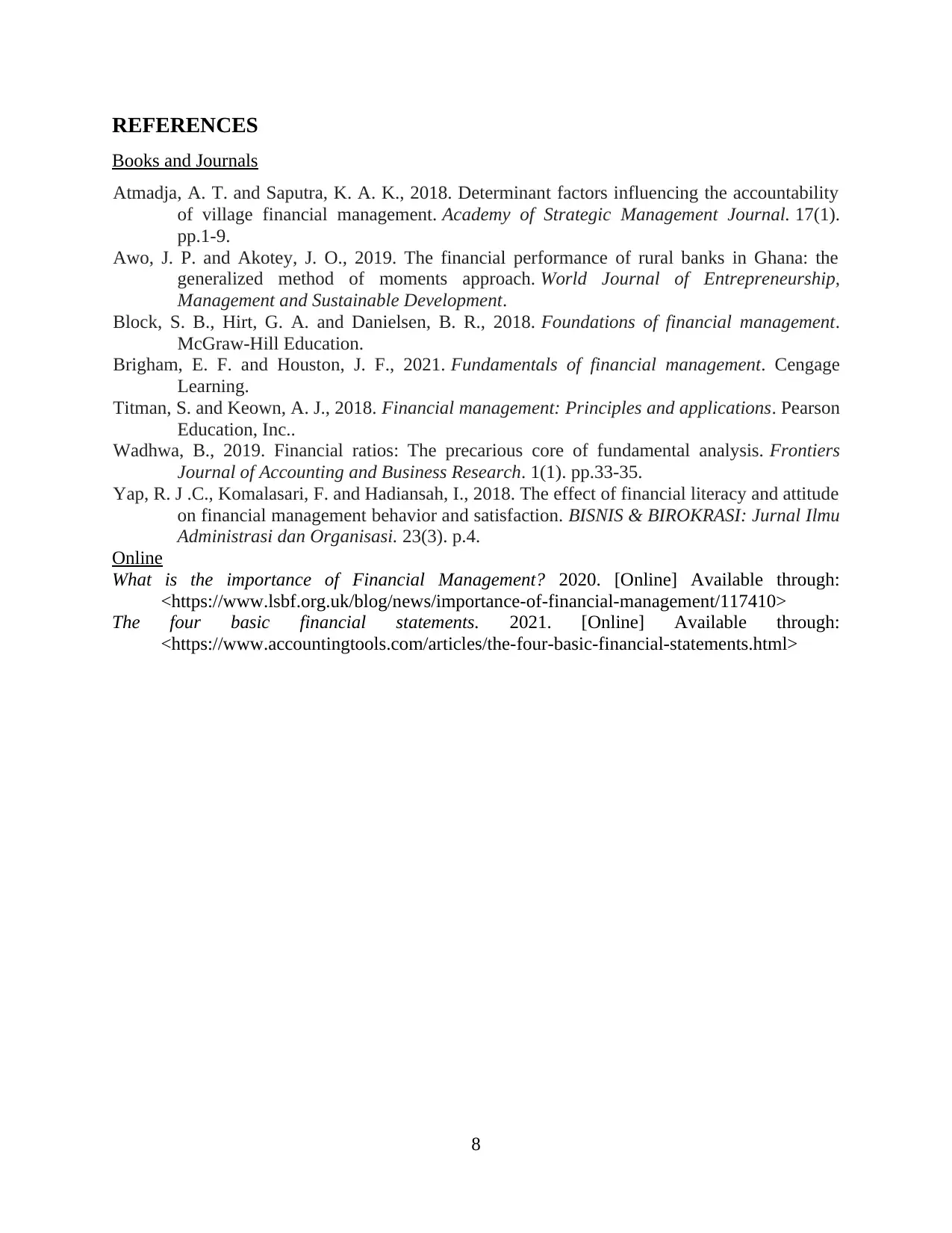
REFERENCES
Books and Journals
Atmadja, A. T. and Saputra, K. A. K., 2018. Determinant factors influencing the accountability
of village financial management. Academy of Strategic Management Journal. 17(1).
pp.1-9.
Awo, J. P. and Akotey, J. O., 2019. The financial performance of rural banks in Ghana: the
generalized method of moments approach. World Journal of Entrepreneurship,
Management and Sustainable Development.
Block, S. B., Hirt, G. A. and Danielsen, B. R., 2018. Foundations of financial management.
McGraw-Hill Education.
Brigham, E. F. and Houston, J. F., 2021. Fundamentals of financial management. Cengage
Learning.
Titman, S. and Keown, A. J., 2018. Financial management: Principles and applications. Pearson
Education, Inc..
Wadhwa, B., 2019. Financial ratios: The precarious core of fundamental analysis. Frontiers
Journal of Accounting and Business Research. 1(1). pp.33-35.
Yap, R. J .C., Komalasari, F. and Hadiansah, I., 2018. The effect of financial literacy and attitude
on financial management behavior and satisfaction. BISNIS & BIROKRASI: Jurnal Ilmu
Administrasi dan Organisasi. 23(3). p.4.
Online
What is the importance of Financial Management? 2020. [Online] Available through:
<https://www.lsbf.org.uk/blog/news/importance-of-financial-management/117410>
The four basic financial statements. 2021. [Online] Available through:
<https://www.accountingtools.com/articles/the-four-basic-financial-statements.html>
8
Books and Journals
Atmadja, A. T. and Saputra, K. A. K., 2018. Determinant factors influencing the accountability
of village financial management. Academy of Strategic Management Journal. 17(1).
pp.1-9.
Awo, J. P. and Akotey, J. O., 2019. The financial performance of rural banks in Ghana: the
generalized method of moments approach. World Journal of Entrepreneurship,
Management and Sustainable Development.
Block, S. B., Hirt, G. A. and Danielsen, B. R., 2018. Foundations of financial management.
McGraw-Hill Education.
Brigham, E. F. and Houston, J. F., 2021. Fundamentals of financial management. Cengage
Learning.
Titman, S. and Keown, A. J., 2018. Financial management: Principles and applications. Pearson
Education, Inc..
Wadhwa, B., 2019. Financial ratios: The precarious core of fundamental analysis. Frontiers
Journal of Accounting and Business Research. 1(1). pp.33-35.
Yap, R. J .C., Komalasari, F. and Hadiansah, I., 2018. The effect of financial literacy and attitude
on financial management behavior and satisfaction. BISNIS & BIROKRASI: Jurnal Ilmu
Administrasi dan Organisasi. 23(3). p.4.
Online
What is the importance of Financial Management? 2020. [Online] Available through:
<https://www.lsbf.org.uk/blog/news/importance-of-financial-management/117410>
The four basic financial statements. 2021. [Online] Available through:
<https://www.accountingtools.com/articles/the-four-basic-financial-statements.html>
8
Paraphrase This Document
Need a fresh take? Get an instant paraphrase of this document with our AI Paraphraser
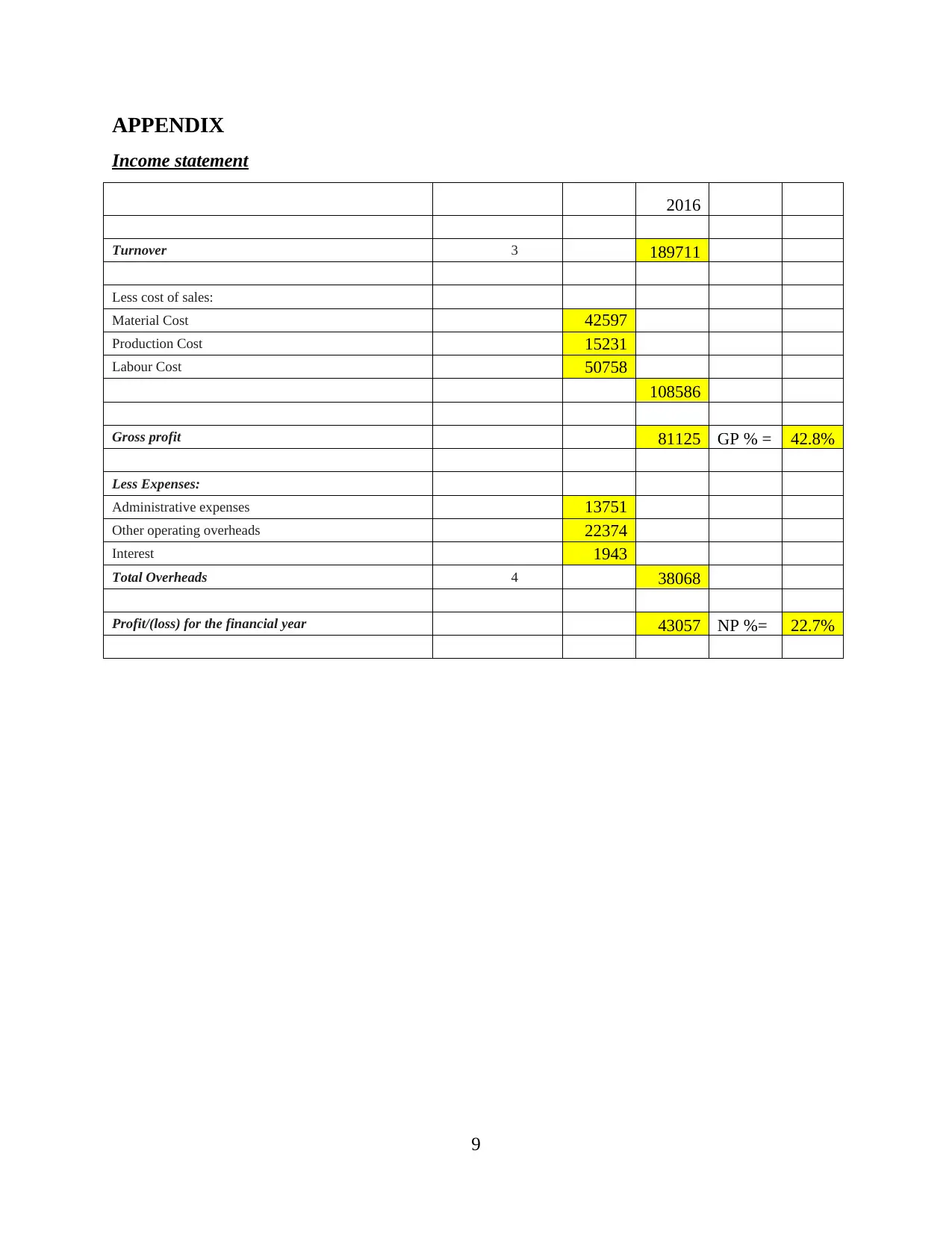
APPENDIX
Income statement
2016
Turnover 3 189711
Less cost of sales:
Material Cost 42597
Production Cost 15231
Labour Cost 50758
108586
Gross profit 81125 GP % = 42.8%
Less Expenses:
Administrative expenses 13751
Other operating overheads 22374
Interest 1943
Total Overheads 4 38068
Profit/(loss) for the financial year 43057 NP %= 22.7%
9
Income statement
2016
Turnover 3 189711
Less cost of sales:
Material Cost 42597
Production Cost 15231
Labour Cost 50758
108586
Gross profit 81125 GP % = 42.8%
Less Expenses:
Administrative expenses 13751
Other operating overheads 22374
Interest 1943
Total Overheads 4 38068
Profit/(loss) for the financial year 43057 NP %= 22.7%
9
1 out of 11
Related Documents
Your All-in-One AI-Powered Toolkit for Academic Success.
+13062052269
info@desklib.com
Available 24*7 on WhatsApp / Email
![[object Object]](/_next/static/media/star-bottom.7253800d.svg)
Unlock your academic potential
Copyright © 2020–2025 A2Z Services. All Rights Reserved. Developed and managed by ZUCOL.




